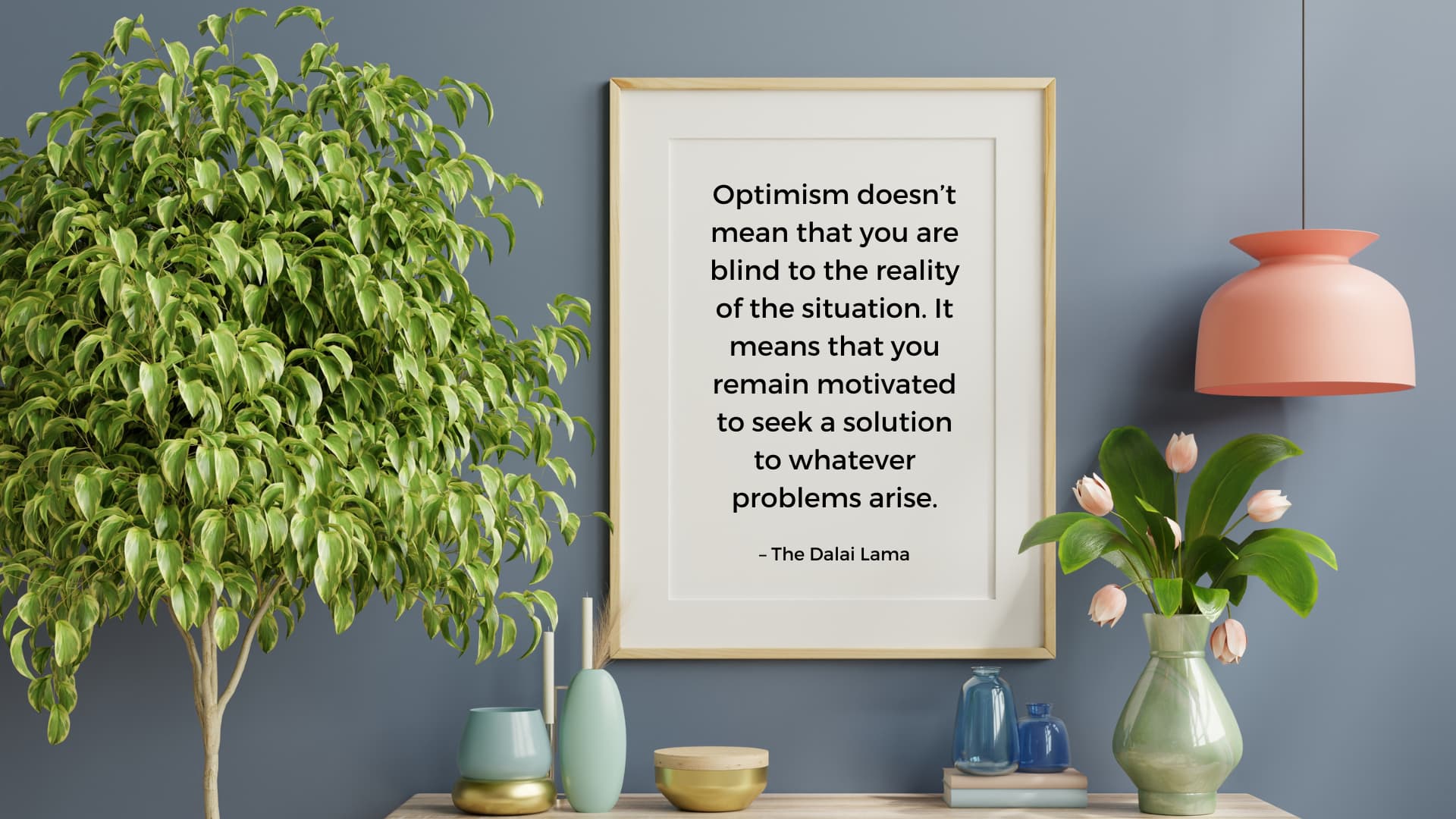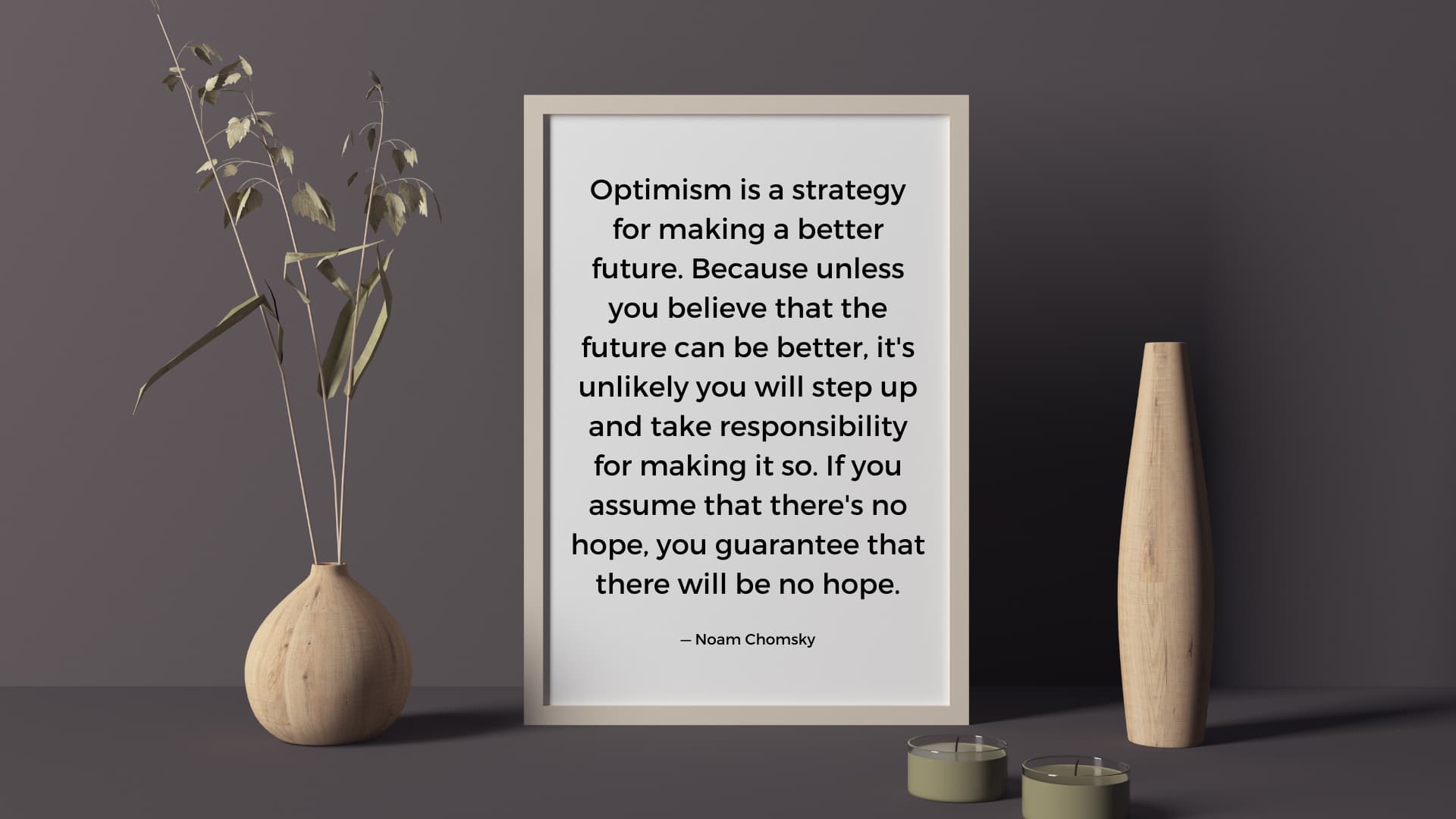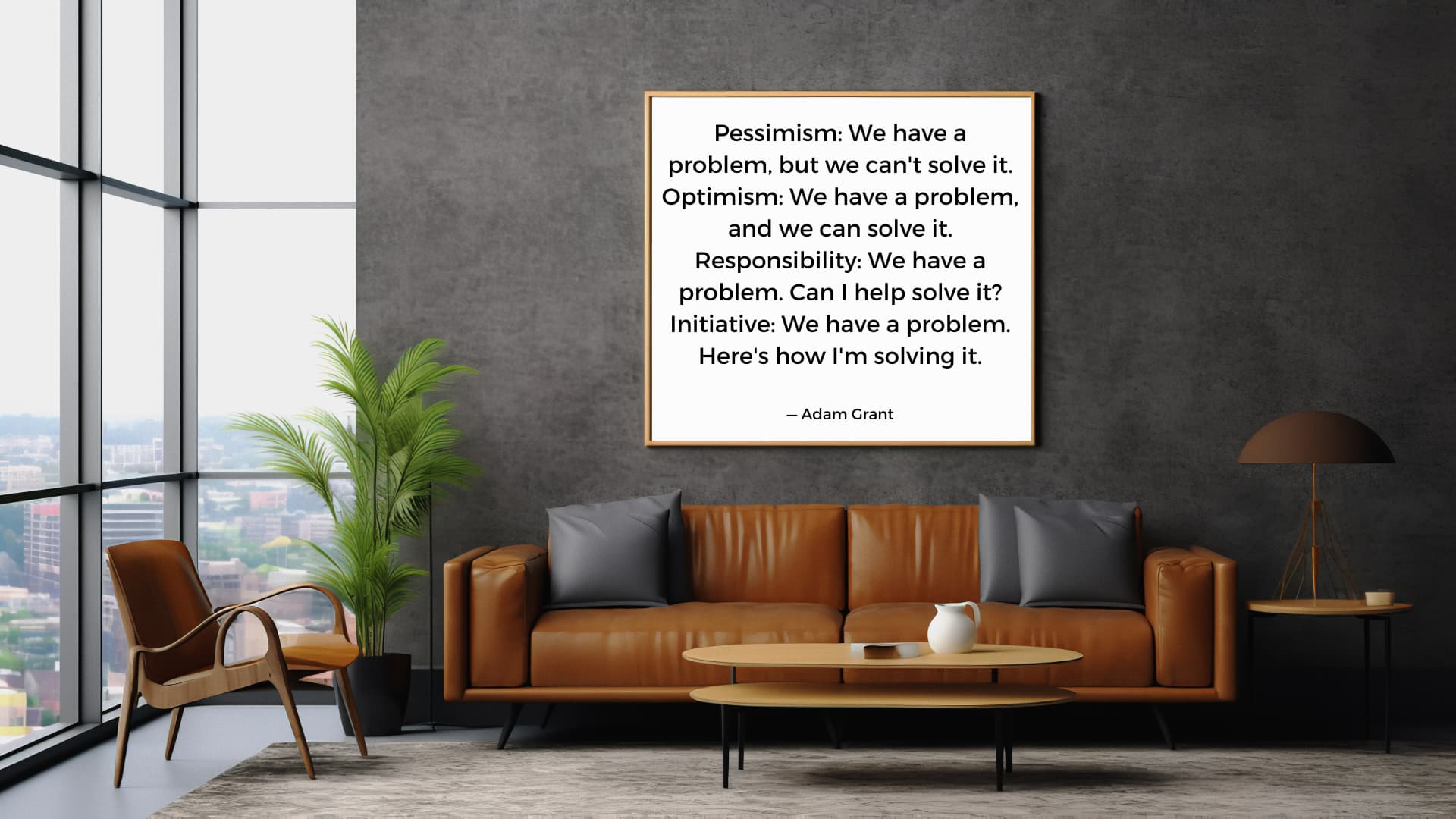3 Strategies to Cultivating a Positive Outlook for a Brighter Future
Nov 13, 2023
In the words of the renowned American author Helen Keller, "Optimism is the faith that leads to achievement. Nothing can be done without hope and confidence." Keller's words are particularly striking when we consider that she overcame tremendous obstacles, including blindness and deafness, to become a celebrated author, lecturer, and an inspiration to countless individuals. Her life is a testament to optimism—a strength we can all tap into to improve our well-being and transform our lives.
The ability to see a brighter future, to believe in one's ability to overcome challenges, and to maintain a positive outlook can transform our lives. This sentiment highlights the profound connection between optimism and well-being, a link increasingly recognised and explored by researchers, psychologists, and individuals seeking a more fulfilling and joyful life.
In this blog post, we'll delve into the concept of optimism and its profound connection to well-being. We'll explore the science behind optimism, examining the positive effects it has on mental and physical health, relationships, and personal fulfilment. By the end of our journey, you'll be equipped with the knowledge and tools to harness positivity for a brighter, more fulfilling future. So, let's dive into the fascinating concepts of optimism and discover how it can illuminate the path to a better, happier life.
Understanding Optimism
Optimism, positivity, and hope are often used interchangeably in conversations about mental well-being. But are they indeed the same thing? What sets optimism apart, and how can it impact our lives? Let's explore the fascinating world of optimism, differentiating it from related concepts and delving into its role in various aspects of life, all backed by research.
Defining Optimism
Optimism is the belief that positive outcomes are more likely than negative ones, even in adversity. It's about maintaining faith in a brighter future, regardless of the challenges we encounter. Conversely, positivity is a broader state of mind characterised by a generally positive outlook. It doesn't necessarily involve a specific expectation of positive outcomes. Hope, too, shares some similarities with optimism, but it doesn't always require a realistic perspective.
Defining what optimism is not can help clarify the concept and dispel common misconceptions. Here are a few things that optimism is not:
Denial of Reality
Optimism does not entail ignoring or denying the existence of problems, challenges, or negative circumstances. It's not about pretending everything is perfect when it's not. Optimists acknowledge difficulties but maintain a belief in positive outcomes and a proactive approach to address them.
Naivety
Optimism is not the same as naivety or blind faith. Optimists do not approach life with unrealistic expectations or without considering potential risks and obstacles. They maintain a positive outlook while staying grounded in reality.
Avoidance of Negative Emotions
Being optimistic doesn't mean suppressing negative emotions or avoiding them altogether. Optimistic individuals can experience sadness, frustration, and disappointment, just like anyone else. However, they tend to bounce back from negative emotions more quickly and focus on solutions and positive aspects.
Ignoring Precautions
Optimism doesn't imply recklessness or a disregard for precautions. Optimists can be cautious and take necessary steps to mitigate risks. They do so with a positive attitude, believing that their efforts can lead to favourable outcomes.
Perpetual Positivity
Optimism doesn't mean being happy all the time. Everyone experiences moments of sadness, stress, and uncertainty. Optimism is about maintaining hope and a positive outlook even during challenging times, rather than a perpetual state of bliss.
In essence, optimism is a balanced and constructive perspective that combines a belief in positive outcomes with a realistic understanding of the world. It's not about ignoring reality or avoiding negative experiences but rather about navigating life's ups and downs with a hopeful and proactive mindset.

Optimism's Impact on Health, Relationships, and Career
Health
Optimism has a profound impact on physical and mental health. A study published in the American Journal of Epidemiology revealed that optimistic individuals tend to live longer and have a lower risk of chronic diseases. They are also more likely to engage in healthy behaviours like exercise and maintaining a balanced diet. The power of a positive outlook can literally add years to your life.
Relationships
Research by Scheier and Segerstrom (2010) highlights that optimism is linked to relationship quality. Optimistic individuals tend to have more positive and supportive interactions with their partners, contributing to overall relationship well-being.
Career
The workplace is another arena where optimism shines. Optimistic employees are more resilient in the face of setbacks, adapt to changes more effectively, and exhibit higher job satisfaction. Research by Luthans et al. (2007) highlights the positive impact of optimism on work performance and job-related well-being. So, if you're seeking career success and satisfaction, optimism could be your secret weapon.
Understanding the Different Types of Optimism
There are several different types of optimism, each with its unique characteristics. These types of optimism provide insight into how individuals approach life with a positive outlook. Here are some of the key types of optimism:
Dispositional Optimism
Definition
Dispositional optimism refers to an individual's inherent, general outlook on life. It's a consistent tendency to expect positive outcomes in various life situations.
Characteristics
Individuals with high dispositional optimism tend to maintain a positive attitude and see the good in most situations, even in the face of adversity.
Implications
High dispositional optimism is associated with lower levels of stress, reduced risk of depression, and better physical health. These individuals often exhibit a strong belief in their ability to overcome challenges and reach their goals.
Explanatory Style Optimism
Definition
Explanatory style optimism focuses on how individuals explain the events in their lives, particularly the causes they attribute to those events.
Characteristics
An optimistic explanatory style involves attributing positive events to one's abilities and efforts, while negative events are seen as external factors or temporary setbacks. It's about framing events in a way that fosters hope and persistence.
Implications
An optimistic explanatory style can enhance resilience and problem-solving abilities. When individuals believe their efforts can lead to positive outcomes, they are more likely to persevere in facing difficulties.

Realistic Optimism
Definition
Realistic optimism is grounded in a balanced assessment of both positive and negative aspects of a situation. It involves acknowledging potential challenges while maintaining hope for a positive outcome.
Characteristics
Realistic optimists tend to approach situations with a pragmatic perspective. They understand the potential obstacles and setbacks but remain hopeful and adaptable.
Implications
Realistic optimism helps individuals set achievable goals and navigate obstacles effectively. It encourages a balanced and practical approach to life, where hope and preparedness coexist.
Illusory Optimism
Definition
Illusory optimism is characterised by an overly positive belief in one's own abilities and future outcomes, even when evidence suggests otherwise. It can sometimes lead to overconfidence and unrealistic expectations.
Characteristics
Individuals with illusory optimism may underestimate risks and overestimate their chances of success in various endeavors.
Implications
While this type of optimism can provide motivation, it can also lead to poor decision-making if not grounded in reality.
It's important to strike a balance between confidence and a realistic assessment of one's capabilities and circumstances.
Defensive Pessimism
Definition
Defensive pessimism is a unique form of optimism where individuals harness anxiety and negative thinking to prepare for future challenges. They anticipate the worst-case scenario as a way to cope with anxiety and perform optimally.
Characteristics
Defensive pessimists may appear negative in their assessments, but this strategy helps them stay focused and prepared. They use their pessimism to set high goals and work hard to avoid failure.
Implications
While it may seem counterintuitive, defensive pessimism can be a useful coping mechanism for some individuals. It allows them to harness anxiety productively and achieve success by taking necessary precautions.
Deliberate or Learned Optimism
Definition
Deliberate or learned optimism is the intentional effort to cultivate a more optimistic outlook through positive thinking, gratitude, and cognitive reframing. This approach was popularised by psychologist Martin Seligman, who outlined the concept of learned helplessness and, subsequently, learned optimism. The basic premise is that individuals can reframe their thinking and attitudes to become more optimistic, even if they have a natural inclination toward pessimism.
Characteristics
This type of optimism is developed through conscious strategies to change one's thought patterns and mindset. It involves training oneself to think optimistically.
Implications
Deliberate or learned optimism can be a powerful tool for personal development, helping individuals shift from a pessimistic to a more optimistic mindset, which can lead to improved well-being and success.
Depending on the situation and one's disposition, different forms of optimism can come into play. Each type has its advantages and potential drawbacks, highlighting the complexity and richness of this positive outlook on life.
These different types of optimism can coexist in individuals to varying degrees. For example, someone may have a high level of dispositional optimism but also employ a realistic approach when facing specific challenges. The key is to strike a balance between optimism and a realistic assessment of situations, leading to better decision-making and improved overall well-being.

How to Become More Optimistic
As highlighted in the concept of 'Deliberate or Learned Optimism,' we can intentionally develop and nurture an optimistic mindset, even if we have a natural inclination toward pessimism. It's all about learning the art of fostering a sunnier perspective on life.
Strategy 1: The 3 Ps of Overcoming Cognitive Distortions
One of the significant roadblocks to optimism is cognitive distortions. These distorted thought patterns can cast a shadow on our perspective, making it challenging to see the silver lining in life's challenges. The Three Ps – Personalization, Permanence, and Pervasiveness offer a pathway to achieving a more optimistic outlook on life.
1. Personalisation - It's Not All About You
Personalisation involves taking personal responsibility for events that are outside your control. You may blame yourself for things that have little or nothing to do with your actions.
Technique to Combat Personalisation:
Reality Check
Pause and ask yourself whether the situation is genuinely your fault or whether other factors played a role. Often, many elements contribute to a situation, and you're not solely responsible.
Empathy for Yourself
Show yourself the same compassion you would offer a friend facing a similar situation. Recognise that you, like everyone else, are bound to make mistakes and face challenges.
Question Your Responsibility
When you catch yourself personalising an event, ask whether there's concrete evidence supporting your responsibility. More often than not, you'll find that it's not as black and white as it seems.
2. Permanence - Storms Don't Last Forever
Permanence involves believing that the effects of negative events will last indefinitely. It's the feeling that a challenging situation will never improve.
Technique to Combat Permanence:
Temporal Perspective
Remind yourself that life is full of ups and downs, and nothing lasts forever. Ask yourself if you've faced challenging situations in the past and eventually moved past them.
Create a Timeline
Visualise the course of your life as a timeline. Remind yourself of past challenges and how they eventually passed. Use this perspective to reduce the sense of permanence in current difficulties.
Adopt a Growth Mindset
Embrace the idea that challenges are opportunities for growth. Recognise that difficulties are temporary and can lead to personal development.
Goal Setting
Establish short-term and long-term goals to give yourself a sense of direction and purpose. Setting achievable milestones can help you focus on progress and change.

3. Pervasiveness - Don't Let One Cloud Obscure the Sun
Pervasiveness involves thinking that a negative event will cast a shadow over all aspects of your life. It's the tendency to generalise one setback to every area of your existence.
Technique to Combat Pervasiveness:
Compartmentalisation
Recognise that negative events or emotions in one area of your life don't need to infect all the others. Keep your perspective compartmentalised so one setback doesn't overshadow your overall well-being.
Balance Sheet
Maintain a balanced perspective by listing the positive and negative aspects of your life. Acknowledging the positive can counter the tendency to let negativity pervade your thoughts.
Count Your Blessings
Regularly engage in gratitude exercises to remind yourself of the positive aspects of your life. This can help counter the feeling of pervasiveness with a more balanced perspective.
When confronted with awareness and practical techniques, the Three Ps can help you dispel the clouds of negativity, allowing the sun of optimism to shine through. By learning to counter personalisation, permanence, and pervasiveness, you'll enhance your well-being and set the stage for a brighter, more optimistic future.
Strategy 2: The ABC technique by Dr. Albert Ellis
Dr. Albert Ellis, a renowned psychologist and the founder of Rational Emotive Behavior Therapy (REBT), developed the ABC technique as a powerful cognitive tool to help people become more optimistic and rational in their thinking. This technique is designed to challenge and change irrational beliefs that can lead to negative emotions and behaviours. Here's how the ABC technique works:
A - Activating Event
The "A" stands for the Activating Event, which is the external situation or event that triggers a particular emotional response. This can be an event, circumstance, or situation that you encounter in your life.
B - Belief
The "B" represents the Belief, which is your interpretation or belief about the activating event. Your beliefs are often influenced by your past experiences, core beliefs, and thought patterns. These beliefs can be rational (based on evidence and reason) or irrational (based on unfounded assumptions or cognitive distortions).
C - Consequence
The "C" signifies the consequence, which is the emotional and behavioural response that results from your belief about the activating event. If your belief is rational, the consequence is likely to be a healthy emotional response. However, if your belief is irrational, the consequence is likely to be negative emotions such as anger, anxiety, sadness, and potentially unhealthy behaviours.
D - Disputation
Dr. Ellis added a "D" to the original ABC model, representing Disputation. This step involves challenging and disputing the irrational belief you identified in the "B" step. The goal is to replace the irrational belief with a more rational and optimistic belief.
E - New Effect
The "E" stands for New Effect, which is the emotional and behavioural response that results from your newly adopted, rational belief. This step involves experiencing a healthier and more optimistic emotional response to the same activating event.

Here's how to become more optimistic using the ABCDE technique:
Identify the Activating Event (A)
Begin by identifying the external event or situation that triggered your emotional response. This event could be a disappointment, criticism, or any situation that caused you distress.
Identify Your Belief (B)
Reflect on the beliefs or thoughts that emerged as a result of the activating event. Are these beliefs rational or irrational? Irrational beliefs often involve "should" or "must" statements, exaggerated thinking, or rigid thinking patterns. These beliefs are often categorised into three types:
1. Irrational Beliefs
These are beliefs that are unrealistic, rigid, or extreme. For example, "I must always succeed," "People should always treat me kindly," or "If I make a mistake, I'm a total failure."
2. Rational Beliefs
These are beliefs that are rational, flexible, and based on evidence and reason. For example, "It's okay to make mistakes; it's a part of life," or "People can be unkind sometimes, and it doesn't define my worth."
Disputing Irrational Beliefs
In this stage, you challenge and dispute your irrational beliefs. Ask yourself questions like, "Is this belief based on facts and evidence? What's the worst that could happen, and can I handle it? Are there alternative, more rational beliefs I can adopt?"
Identify the Consequence (C)
Examine the emotional and behavioural consequences of your belief about the activating event. Did you experience negative emotions or engage in unhealthy behaviours?
Dispute the Irrational Belief (D)
Challenge the irrational belief by asking yourself questions like:
- Is my belief based on evidence, or is it an assumption?
- What's the worst that could happen, and how likely is it to occur?
- Have I dealt with similar situations before, and how did it turn out?
- What are the potential benefits of a more rational belief?
- Is there an alternative, more balanced way to view the situation?
Replace the irrational belief with a more rational and optimistic one.
Experience the New Effect (E)
After disputing the irrational belief, notice your emotional and behavioural response to the same activating event change. You're likely to experience more optimistic and rational emotions and behaviours.
This technique encourages you to confront and change irrational beliefs, leading to more optimistic thinking and healthier emotional responses. Over time, with practice, this technique can help you become more optimistic, resilient, and better equipped to handle life's challenges.

Strategy 3: The Best Possible Self Technique
In the quest for optimism and well-being, we often find ourselves seeking answers outside, chasing elusive sources of happiness. But what if I told you that the key to a brighter future might actually lie within you? Enter the "Best Possible Self" exercise, a powerful technique that has been scientifically proven to boost well-being and mood. Let's dive into this transformative practice and explore how it can pave the way for a more optimistic and fulfilling life.
What is the Best Possible Self Exercise?
The Best Possible Self (BPS) technique is a positive psychology exercise that encourages individuals to imagine and write about a future in which everything has turned out for the best. It invites you to create a vivid mental picture of your life in a way that brings you maximum happiness, fulfilment, and optimism.
How to Practice the Best Possible Self Exercise:
1. Find a Quiet Space
Set aside some quiet time for yourself, free from distractions.
2. Write It Down
Begin by writing about your Best Possible Self. Describe, in detail, how you envision your ideal life. Consider various aspects, including career, relationships, health, and personal achievements. Be as specific as possible.
3. Use Positive Language
Frame your descriptions in positive, optimistic language. Focus on what you want to achieve and experience rather than what you want to avoid or eliminate.
4. Engage Your Senses
Bring your visualisation to life by engaging your senses. Imagine how you would feel, what you would see, and hear in your Best Possible Self.
5. Set Realistic Goals
While it's essential to dream big, ensure your goals remain realistic. This exercise is about optimism, not fantasy.
The Science Behind the Best Possible Self
The Best Possible Self exercise works because it steers your focus toward positivity, hope, and possibilities. When you envision a future where everything goes well, your brain responds by releasing feel-good neurotransmitters like dopamine. This exercise can shift your focus from current challenges and stressors to a brighter, more optimistic future. It can also remind you that your dreams and aspirations are achievable, boosting your confidence and motivation.
Research supports the effectiveness of the BPS technique in enhancing well-being and optimism. A study by Peters, Flink, Boersma, and Linton (2010) delved into the effects of writing about one's Best Possible Self. They discovered that this practice not only improved well-being but also led to better sleep and a reduction in symptoms of anxiety and depression. Meevissen and her colleagues (2011) extended this research, revealing that envisioning your Best Possible Self elevates mood and enhances goal attainment and problem-solving abilities.

Final Thoughts
Throughout this journey, we've uncovered the science behind optimism, the various types of optimism, and practical techniques to cultivate a brighter outlook. It's the lens through which we view the world, a lens that has the incredible ability to shape our experiences. We've seen evidence that optimism is linked to greater resilience, reduced stress, enhanced relationships, improved mental and physical health, and a better overall quality of life.
In summary, here are the key takeaways:
Optimism Is a Skill
Optimism is not solely an inborn trait. It's a skill that can be cultivated through deliberate effort and practice.
Conquer Cognitive Distortions
Identifying and countering cognitive distortions, like personalisation, permanence, and pervasiveness, is essential for a more optimistic mindset.
The ABCDE of Optimism
Dr. Albert Ellis's ABCDE technique provides a roadmap for disputing irrational beliefs and fostering optimism.
The Best Possible Self
Envisioning your Best Possible Self is a scientifically validated technique that can enhance well-being, mood, and even problem-solving abilities.
Optimism is the force that turns adversity into opportunity, despair into hope, and doubt into belief. It's the compass that guides us through life's twists and turns, reminding us that even in adversity, a brighter day is just around the corner. Now, the question is, how can you harness optimism in your life?
Are you ready to believe in the beauty of your aspirations and to face each day with the unwavering belief that a brighter future is not just a hope but a reality waiting to be written? As you harness the positivity within you, you become the creator of your destiny. Your brighter future awaits, and it begins with optimism.
With gratitude,

The content, products and services of this website are not meant to substitute any advice provided by mental health and medical professionals. If you suspect that you're facing mental-health-related problems, you're strongly encouraged to seek professional help.
References:
Lee LO, James P, Zevon ES, Kim ES, Trudel-Fitzgerald C, Spiro A 3rd, Grodstein F, Kubzansky LD. Optimism is associated with exceptional longevity in 2 epidemiologic cohorts of men and women. Proc Natl Acad Sci U S A. 2019 Sep 10;116(37):18357-18362. doi: 10.1073/pnas.1900712116. Epub 2019 Aug 26. PMID: 31451635; PMCID: PMC6744861.
Eric S. Kim, Kaitlin A. Hagan, Francine Grodstein, Dawn L. DeMeo, Immaculata De Vivo, Laura D. Kubzansky, Optimism and Cause-Specific Mortality: A Prospective Cohort Study, American Journal of Epidemiology, Volume 185, Issue 1, 1 January 2017, Pages 21–29,
Carver, C. S., Scheier, M. F., & Segerstrom, S. C. (2010). Optimism. Clinical Psychology Review, 30(7), 879-889.
Giltay, E. J., Geleijnse, J. M., Zitman, F. G., Hoekstra, T., & Schouten, E. G. (2004). Dispositional optimism and all-cause and cardiovascular mortality in a prospective cohort of elderly Dutch men and women. "Archives of General Psychiatry," 61(11), 1126-1135.
Segerstrom, S. C. (2005). Optimism and immunity: Do positive thoughts always lead to positive effects? "Brain, Behavior, and Immunity," 19(3), 195-200.
Peters, M. L., Flink, I., Boersma, K., & Linton, S. J. (2010). Manipulating optimism: Can imagining a best possible self be used to increase positive future expectancies? The Journal of Positive Psychology, 5(3), 204–211. https://doi.org/10.1080/17439761003790963
Meevissen, Y. M., Peters, M. L., & Alberts, H. J. E. M. (2011). Become more optimistic by imagining a best possible self: Effects of a two week intervention. Journal of Behavior Therapy and Experimental Psychiatry, 42(3), 371–378. https://doi.org/10.1016/j.jbtep.2011.02.012




